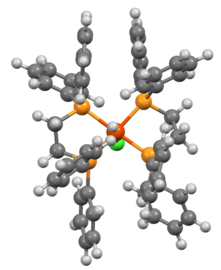Our website is made possible by displaying online advertisements to our visitors.
Please consider supporting us by disabling your ad blocker.
Hydrure de chlorobis(dppe)fer
| Hydrure de chlorobis(dppe)fer | |

| |
| Structure de l'hydrure de chlorobis(dppe)fer | |
| Identification | |
|---|---|
| No CAS | |
| SMILES | |
| InChI | |
| Propriétés chimiques | |
| Formule | C52H49ClFeP4 |
| Masse molaire[1] | 889,139 ± 0,049 g/mol C 70,24 %, H 5,55 %, Cl 3,99 %, Fe 6,28 %, P 13,93 %, |
| Unités du SI et CNTP, sauf indication contraire. | |
| modifier |
|
L'hydrure de chlorobis(dppe)fer est un complexe de coordination de formule chimique HFeCl(dppe)2, où « dppe » représente le ligand bidentate 1,2-bis(diphénylphosphino)éthane (C6H5)2PCH2CH2P(C6H5)2. Il se présente sous la forme d'un solide rouge violacé. Il a suscité un intérêt en recherche comme précurseur des complexes de dihydrogène[2]. Ce complexe présente une géométrie moléculaire octaédrique. Les ligands hydrure et chlorure sont en configuration trans l'un par rapport à l'autre[3]. On peut l'obtenir à l'aide de la réaction idéalisée[4] :
Au cours de ce processus, le complexe FeCl2(dppe)2 haut spin est converti en HFeCl(dppe)2 bas spin.
Le complexe HFeCl(dppe)2 présente un ensemble de réactions associées à la liaison Fe–Cl. Il réagit avec le borohydrure de sodium en donnant le dihydrure :
La réaction avec le tétrafluoroborate de sodium NaBF4 sous atmosphère d'hydrogène H2 ou d'azote N2 donne respectivement le complexe de dihydrogène et le complexe de diazote[5] :
- HFeCl(dppe)2 + NaBF4 + H2 ⟶ [HFe(H2)(dppe)2]BF4 + NaCl ;
- HFeCl(dppe)2 + NaBF4 + N2 ⟶ [HFe(N2)(dppe)2]BF4 + NaCl.
- Modélisation du complexe
-
Vue latérale
-
Vue axiale
- ↑ Masse molaire calculée d’après « Atomic weights of the elements 2007 », sur www.chem.qmul.ac.uk.
- ↑ (en) Robert H. Morris, « Dihydrogen, dihydride and in between: NMR and structural properties of iron group complexes », Coordination Chemistry Reviews, vol. 252, nos 21-22, , p. 2381-2394 (DOI 10.1016/j.ccr.2008.01.010, lire en ligne)
- ↑ (en) Jae-Gyung Lee, Geon-Soo Jung et Soon W. Lee, « Structure of trans-Chlorohydridobis(diphenylphosphinoethane)iron(II) », Bulletin of the Korean Chemical Society, vol. 19, no 2, , p. 267-269 (DOI 10.5012/BKCS.1998.19.2.267, lire en ligne)
- ↑ (en) P. Giannoccaro, A. Sacco, Steven D. Ittel et Martin A. Cushing Jr., « Bis[Ethylenebis(Diphenylphosphine)]-Hydridoiron Complexes », Inorganic Syntheses, vol. 17, (DOI 10.1002/9780470132487.ch19, lire en ligne)
- ↑ (en) Maria T. Bautista , Lynikka D. Bynum et Cynthia K. Schauer, « Synthesis of η2-Dihydrogen Complex, trans-{Fe(η2-H2)(H)[1,2-bis(diphenylphosphino)-ethane]2}[BF4]: An Experiment for an Advanced Inorganic Chemistry Laboratory Involving Synthesis and NMR Properties of an η2-H2 Complex », Journal of Chemical Education, vol. 73, no 10, , p. 988 (DOI 10.1021/ed073p988, Bibcode 1996JChEd..73..988B, lire en ligne)
Previous Page Next Page




